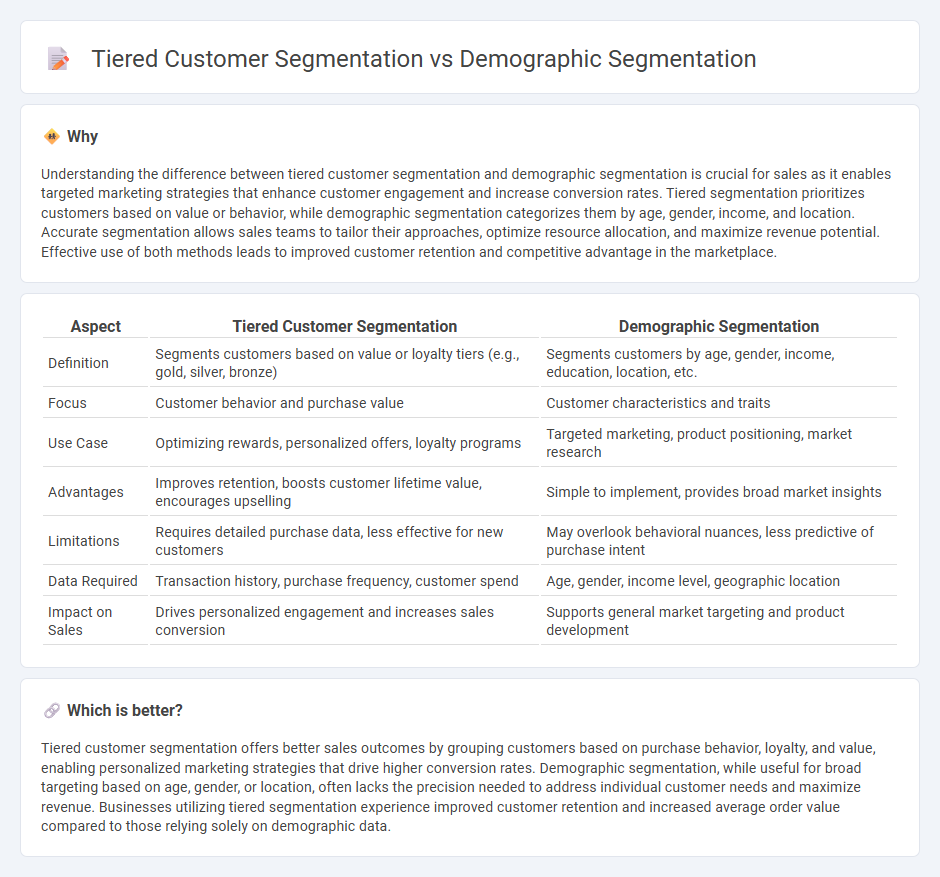
Tiered customer segmentation categorizes buyers based on spending levels, loyalty, or engagement to tailor marketing strategies and maximize revenue potential. Demographic segmentation divides customers by age, gender, income, or location, focusing on shared characteristics for targeted messaging. Explore the benefits of each approach to optimize your sales strategy effectively.
Why it is important
Understanding the difference between tiered customer segmentation and demographic segmentation is crucial for sales as it enables targeted marketing strategies that enhance customer engagement and increase conversion rates. Tiered segmentation prioritizes customers based on value or behavior, while demographic segmentation categorizes them by age, gender, income, and location. Accurate segmentation allows sales teams to tailor their approaches, optimize resource allocation, and maximize revenue potential. Effective use of both methods leads to improved customer retention and competitive advantage in the marketplace.
Comparison Table
| Aspect | Tiered Customer Segmentation | Demographic Segmentation |
|---|---|---|
| Definition | Segments customers based on value or loyalty tiers (e.g., gold, silver, bronze) | Segments customers by age, gender, income, education, location, etc. |
| Focus | Customer behavior and purchase value | Customer characteristics and traits |
| Use Case | Optimizing rewards, personalized offers, loyalty programs | Targeted marketing, product positioning, market research |
| Advantages | Improves retention, boosts customer lifetime value, encourages upselling | Simple to implement, provides broad market insights |
| Limitations | Requires detailed purchase data, less effective for new customers | May overlook behavioral nuances, less predictive of purchase intent |
| Data Required | Transaction history, purchase frequency, customer spend | Age, gender, income level, geographic location |
| Impact on Sales | Drives personalized engagement and increases sales conversion | Supports general market targeting and product development |
Which is better?
Tiered customer segmentation offers better sales outcomes by grouping customers based on purchase behavior, loyalty, and value, enabling personalized marketing strategies that drive higher conversion rates. Demographic segmentation, while useful for broad targeting based on age, gender, or location, often lacks the precision needed to address individual customer needs and maximize revenue. Businesses utilizing tiered segmentation experience improved customer retention and increased average order value compared to those relying solely on demographic data.
Connection
Tiered customer segmentation organizes customers into hierarchical groups based on their purchasing behavior, while demographic segmentation categorizes these groups by age, income, gender, or location. Combining both methods enhances sales strategies by targeting specific customer tiers with tailored messaging and offers that resonate with their demographic profiles. This integrated approach increases conversion rates and optimizes resource allocation in sales campaigns.
Key Terms
Age Group (Demographic Segmentation)
Demographic segmentation divides customers based on age groups such as Gen Z, Millennials, Gen X, and Baby Boomers, enabling businesses to tailor marketing strategies to generational preferences and behaviors. Tiered customer segmentation further refines this by layering age groups with additional criteria like purchasing power, loyalty status, or product usage frequency to create more precise customer tiers. Explore how combining demographic and tiered segmentation can enhance targeted marketing efforts and improve customer engagement.
Income Level (Demographic Segmentation)
Demographic segmentation based on income level classifies customers into groups such as low, middle, and high-income earners to tailor marketing strategies effectively. Tiered customer segmentation further refines these groups by creating distinct service or product tiers, addressing varying affordability and preferences within each income bracket. Explore more to understand how integrating both approaches can enhance targeted marketing efforts.
Customer Value Tier (Tiered Customer Segmentation)
Demographic segmentation categorizes customers based on age, gender, income, and location, while tiered customer segmentation focuses on grouping customers by their value to the business, such as high-value, mid-value, or low-value tiers. Customer Value Tier segmentation helps businesses allocate resources efficiently by targeting marketing efforts and personalized offers according to the spending habits, loyalty, and profitability of each tier. Explore more insights on optimizing customer segmentation strategies to maximize revenue and customer satisfaction.
Source and External Links
Demographic Segmentation Defined with 5 Marketing Examples - This article explores demographic segmentation, focusing on traits like age, gender, income, occupation, and family status to create targeted marketing campaigns.
Demographic Segmentation Overview - This overview details demographic segmentation as a method to group consumers by age, gender, income, occupation, and other shared characteristics for effective marketing.
Demographic Segmentation - Definition, Types & How-tos - This guide explains demographic segmentation as a strategy to divide audiences based on factors like age, gender, and income to tailor marketing efforts effectively.
 dowidth.com
dowidth.com